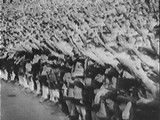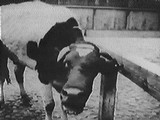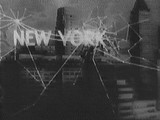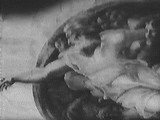|
After having shown these rushes at the Führer's dinner-table on
October 28, he went to Lodz to see for himself. Again he was shocked
and wrote in his diary, that the Jewish Question was more a task for
the surgeon than a humanitarian one. He most probably brought his
script-writer, Eberhard Taubert, and a very loyal cameraman, Erich
Stoll, to make supplementary shots. Some of the shots in the final
version definitely have a different, more manipulated
recording-technique than the rest of the ghetto scenes (use of
distorting lenses, angle and light).
Just a note about my efforts to identify shots by weather. The
ghetto scenes have partly sunshine, partly clouds before the sun. The
weather report from Lodz disappeared during the war, but the
meteorologists could reconstruct the general weather in Lodz between
October 11 and 13. It was on the border between a major high pressure
to the southeast and a major low pressure in the northwest, i.e. I
could not use my observations for anything constructive. I was,
however, able to find some shots which derived from earlier newsreels.
A handbook of the Propaganda Ministry from 1940 gave me the answer
to where the other film clips came from: The Reichsfilmarchive. I have
looked through a lot of films at the Filmdepartment of Bundesarchiv -
at that time in Koblenz - and could identify a lot of my shots. Later
I have been able to supplement my knowledge in the former GDR film
archive. The two have now merged and are situated in Berlin.
Now the still photos were to be identified. This happened mostly
during the time when I searched for the ideological roots of the
spoken commentary. The Royal Library in Copenhagen has a department
for Jewish Studies, which collected antisemitica during the 30s and
40s - and because of the Danish collaboration with Germany, it was
never confiscated. It was simply a treasury, which made it clear to
me how Goebbels and Taubert had worked out the concept.
In November 1937 there opened an exhibition called "Der ewige Jude"
in Munich - and the film was conceived as a filmed version of
this exhibition. The Royal Library had the booklet, which had been
given out by Hans Diebow and contained a lot of the pictures. The
Royal Library also had many copies of the book "Die Juden in
Deutschland," which was a "scientific" report and also had given many
ideas to the different topics, statistics, etc., in the film. This book
came out in revised editions each year and was published by the
Institut zum Studien der Judenfrage, which had been created by
Eberhard Taubert in 1934.
Through an analysis of the rest of Nazi antisemitic propaganda in
the Royal Library, I could identify almost all the rest - and because
of its "scientific" appearance, I also got the clues of how to
evaluate the truth in the claims. Because I could come very far with
some parts of the film, I decided to try to crack it all in a
systematic way, which - to my knowledge - had never happened in such a
way before. This is the reason, why it has taken 25 crazy years to
complete the source-critical edition, which came out two years ago at
the Institute for the Scientific Film in Göttingen.
Was it worth the effort? I hope so - and I do hope that I have
proven the necessity for historians to make such kinds of
time-consuming and very difficult film analysis.
My research project started as a purely methodological task, given
me by my Professor, who wanted pedagogical examples for his book on
film and history. In my first summary I compared the opinions of film
historians, who claimed that the film was intended as propaganda for
the Holocaust, with that of contemporary historians, who based their
opinion of the Genesis of the Holocaust on written evidence. I
concluded that, for chronological reasons, the film could not have been
deliberate propaganda for the mass killing of Jews - and started off to
show that the opinions of the film historians must have been based on
hindsight. Nothing in the film itself could be used as arguments for
this notion.
But it became more and more problematic to explain certain details.
The film is constructed down to the very last detail. The makers were
almost "scientific" in the way they used their sources. Nothing happens
in this film which had not been accepted by Hitler - and Goebbels, who
had to recut it several times to please Hitler. The ritual slaughter
made Goebbels express a wish for the annihilation of the Jews when he
saw for the first time - and it is clear from my reconstruction of the
development of the film that it got stronger and more hateful all the
time. We know that Hitler loved films and we have a lot of evidence
concerning other films which have had strong influence on him.
In short: the more I tried to find evidence against the film
historians, the more I came up with documentation and elementary
arguments which supported them.
Having just written an article for Historical Journal for Film,
Radio and Television in 1991 (came out in 1992), I had one month with
Serbian and one month with Croatian Television. My interest in
propaganda made me watch a lot, and my wife - who speaks it fluently -
translated some of it. However, also without her help it was easy to
compare the whole programming and the reports etc. with the Nazi film
production, which I know so well. It was shocking to see how nothing
really had changed - and I suddenly understood the impact of "produced
reality" in reality-like media such as film and television. This is a
necessary condition for making people believe that they are doing
something good for their society, when they exterminate the enemy who
is dehumanized by this form of strong emotional propaganda.
The only difference between modern genocidal television and the Nazi
version in "Der ewige Jude" was that the ultimate icon for
dehumanization in Serbia and Croatia is mutilated bodies, whereas "Der
ewige Jude" uses the ritual slaughter scenes for this purpose, before
Hitler puts forth what is going to happen with the Jews.
I simply had to believe my own analysis and start to use the
production of the film as the chronological structure for a new
interpretation of the decision-making process. I have promised Jim not
to go any deeper into the results of my latest research into this. If
some of you are able to read Danish, I have written a thick book
in Danish - which has just been transformed to a major TV-series,
intended for the international market. However, you are welcome to ask
me some questions concerning this afterwards.
Instead I would like to raise some crucial questions with regards to
the film. Goebbels' diaries document that the decision to make an
overall antisemitic propaganda film in the style of an extended
newsreel was made on October 4, just after having seen the latest
newsreel, which contained a longer story on Jewish life in Polish
ghettos. He outlined his concept on October 5 to Fritz Hippler, Head of
the Film Department, and Eberhard Taubert, who was an expert for
anti-Bolshevik and anti-Semitic propaganda. Goebbels wrote in his
diary, that the film should be finished within three or four weeks, but
it took longer, since the first public screening took place on November
28, 1940.
There are many reasons for this delay:
First of all, Goebbels had underestimated the whole project. Anyone
who has worked on a major documentary knows how one again and again has
to cut and recut and rewrite and cut again and so on.
Equally important for the delay was that the Führer wanted to
survey the film during the production and ordered several changes
before giving his endorsement. This apparently happened on May 20,
1940, the day when German troops reached the English Channel, thus
making the victory over France a matter of one month. The script for
the film was then sent to Goebbels' archenemy, Alfred Rosenberg, who
only had few comments (probably because he knew that it had already
been accepted by Hitler).
A further delay came, because Goebbels wanted to launch a
feature-film
"Jud Süß"
at the same time. The feature film should arouse anti-Semitic feelings,
which then were to be "proven" by the so-called "documentary." The two
films were also intended for different audience: Jew Süss for the
general public - and Der ewige Jude for those, who were already
anti-Semites or part of the Nazi establishment. Der ewige Jude should
mobilize and legitimize. "Jud Süß" took, however, time to produce -
and was finally finished in late August. It was then shown in Venice on
September 6, 1940.
 |
Two days later, Goebbels screened "Der ewige Jude" as part of an
enlarged press conference. He talked about the need to make new and
stronger war propaganda. The whole top-leadership of The Third Reich
was present. However, there seems to have been a strong reaction
against showing the ritual slaughter in public. After a week - he must
have contacted Hitler, but there is no mention of this in his diary -
he decided that the film should be shown in public cinemas, but in two
versions. One without slaughtering for women and children during the
afternoon - and the original one for men in the evenings.
Finally, on November 28, 1940, the film had its opening night. The
Press had been asked to write big articles on the film on the
political pages, not - as usual - on the film pages. Fritz Hippler gave
an interview in the radio, where he concluded with Hitler's notorious
prophecy, at the same time underlining, that the precondition for the
fulfillment of the prophecy - the war - had occurred. And Hitler
himself started to endorse this interpretation by referring to this
prophecy from January 30, 1941 and later again and again.
On January 20, 1941, the SD wrote a report on the reception of the
film. From this we learn, that the general population did not want to
see it because of the "realistic presentation" of the Jews. The report also
points to the fact that there had been oral propaganda against the
film because of the slaughtering scenes. The audiences had primarily
been political activists. From Goebbels' diary we know that he was
pleased with the report, although it clearly indicated that only few
had seen it. Goebbels knew well that effects depend on what kind of
people you reach. And "Der ewige Jude" was intended for the future
perpetrators - and also as a warning to the rest of the German
population not to interfere with businesses of the state.
Goebbels believed so much in the effectiveness of the film, that it
was obligatory for the Hitler Jugend at their Filmfeierstunden. During
my different showings of the film in Germany I have met several who can
remember it and tell about how and when they saw it. One came from the
Sudetenland, where the whole village was forced to see both "Jud
Süß" and "Der ewige Jude." He could not remember the year,
but he could never forget the feeling he had, as he stepped out from
the cinema and into spring with flowers, sun, humming bees, etc. It
must have been Spring 1942. Other earlier members of the Hitler Jugend,
however, swear that they never saw the film.
The film was also shown to the Wehrmacht and to the Einsatzgruppen.
A Dane, who lived in Berlin until mid-1943, told me that he saw it in
the early summer of that year in a cinema at Kurfürstendamm -
apparently as ideological preparation to the deportation of the Berlin
Jews.
Goebbels also had a Dutch and a French version produced - and in
connection with the planned trial against Grynzpan as part of the
cover-up around the Wannsee-Conference, he even produced an
international version in German, where Hitler's prophecy had been cut
out.
After the war it was forbidden to show in public, and the Allies
took it back to their own country. But Kennedy, visiting Berlin, gave
the rights back as a symbolic gesture: now the Federal Republic of
Germany had become a well-functioning democracy and could also take
care of this black chapter of its history. The rights are now with the
Federal Archives, which has transferred the users' right to a
state-owned company, Transit-Film in Munich. It still belongs to the
so-called Forbidden Films - and television companies are only allowed
to use up to 3 minutes of the film (and are of course obliged to pay
around 30 Deutschmarks per meter of 35 mm film).
The rights for the universities has been transferred to the
Institute for the Scientific Film in Göttingen, which rents out
the film to university teachers. Apart from this one can get a
dispensation, if the arrangement is a closed one and part of the
"political education" - and if the speaker is recognized as an expert
in this field.
And yet, it is easy to obtain the film on video, if one wants to
have it. Since the mid-70s it has been available from neo-Nazi postal
boxes. And it can be bought openly from a company in Chicago, called
International Historic Films. Transit Film has tried to stop it, but
in vain. The way the company sells it means that it is covered by The
First Amendment.
For many reasons I consider "Der ewige Jude" on the whole as no
less than one of the most important sources on the history of the 20th
century. I am therefore doing my best to make the film - or at least
part of it - available for teaching history. The Bundeszentrale
für politische Bildung has bought a special edition of the
source-critical book and distributed it along its normal lines. Next
year there will be a conference about "Enemy pictures" arranged by the
Bundeszentrale as well as the German Association of Teachers in
History, based on "Der ewige Jude" and my didactical experiences of
using the film to teach not only Nazism and the Holocaust, but also
ethics and the impact of media-produced reality.
The discussion after Goldhagen's "Hitler's Willing Executioners"
has once more demonstrated the public need for understanding how it
could happen - how ordinary citizens like you and me could participate
in genocide. The support among ordinary Germans today for Goldhagen's
thesis also demonstrates the need for historians to communicate with
the public on the communicative conditions of the audience. One is the
reasons for his commercial success is that the book is written in a
very personal and dedicated way. As historians we have to compete with
a lot of other things in order to have the attention of our audience
at all.
This is perhaps my main argument for a more active use of the film
"Der ewige Jude" which gives us an X-ray of the legitimization of the
Holocaust and challenges us individually with the uncomfortable moral
question: What would you have done? How do you react to atrocities
today, which you can follow almost live on television?
"Der ewige Jude" is probably the most efficient propaganda film
ever made. It has also become the blueprint for other ruthless
propaganda makers in their way of motivating ordinary citizen to
genocidal behaviour. Therefore I would close my papers with an offer
to you of establishing some kind of cooperation in order to find the
best way to use this knowledge as one little step in the struggle for
a more human and humanistic world.
Thank you very much for your attention!

Additional information about the movies referenced is available at
the
Internet Movie Database:
| 




